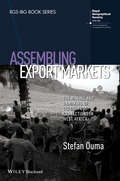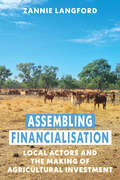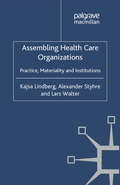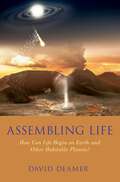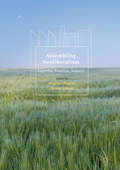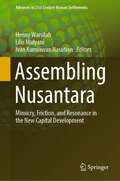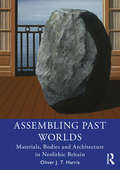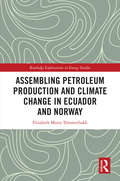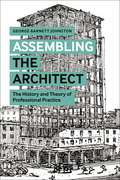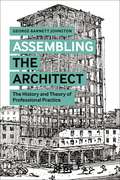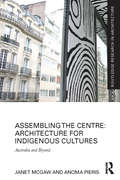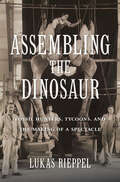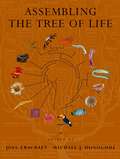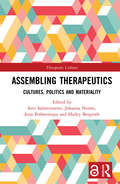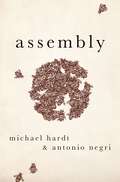- Table View
- List View
Assembling Export Markets: The Making and Unmaking of Global Food Connections in West Africa (RGS-IBG Book Series)
by Stefan OumaAssembling Export Markets explores the new ‘frontier regions’ of the global fresh produce market that has emerged in Ghana over the past decade. Represents a major and empirically rich contribution to the emerging field of the social studies of economization and marketization Offers one of the first ethnographic accounts on the making of global commodity chains ‘from below’ Denaturalizes global markets by unpacking their local engagement, materially entangled construction, need for maintenance, and fragile character Offers a trans-disciplinary engagement with the construction and extension of market relations in two frontier regions of global capitalism Critically examines the opportunities and risks for firms and farms in Ghana entering global fresh produce markets
Assembling Export Markets: The Making and Unmaking of Global Food Connections in West Africa (RGS-IBG Book Series)
by Stefan OumaAssembling Export Markets explores the new ‘frontier regions’ of the global fresh produce market that has emerged in Ghana over the past decade. Represents a major and empirically rich contribution to the emerging field of the social studies of economization and marketization Offers one of the first ethnographic accounts on the making of global commodity chains ‘from below’ Denaturalizes global markets by unpacking their local engagement, materially entangled construction, need for maintenance, and fragile character Offers a trans-disciplinary engagement with the construction and extension of market relations in two frontier regions of global capitalism Critically examines the opportunities and risks for firms and farms in Ghana entering global fresh produce markets
Assembling Financialisation: Local Actors and the Making of Agricultural Investment
by Zannie LangfordFarmers, Indigenous organisations, government and private-sector intermediaries from remote Northern Australia often negotiate with private finance capital to gain funds for agricultural development.The concept of financialisation is used to explore the drivers and effects of agrifood restructuring in the area, while assemblage theory is applied to position local actors as potential sites of power in negotiating connections between local spaces and global finance. This book demonstrates that while financialisation is a useful signifier of patterns of global change, it is assembled by a diverse range of often contradictory work.
Assembling Financialisation: Local Actors and the Making of Agricultural Investment
by Zannie LangfordFarmers, Indigenous organisations, government and private-sector intermediaries from remote Northern Australia often negotiate with private finance capital to gain funds for agricultural development.The concept of financialisation is used to explore the drivers and effects of agrifood restructuring in the area, while assemblage theory is applied to position local actors as potential sites of power in negotiating connections between local spaces and global finance. This book demonstrates that while financialisation is a useful signifier of patterns of global change, it is assembled by a diverse range of often contradictory work.
Assembling Financialisation: Local Actors and the Making of Agricultural Investment
by Zannie LangfordFarmers, Indigenous organisations, government and private-sector intermediaries from remote Northern Australia often negotiate with private finance capital to gain funds for agricultural development.The concept of financialisation is used to explore the drivers and effects of agrifood restructuring in the area, while assemblage theory is applied to position local actors as potential sites of power in negotiating connections between local spaces and global finance. This book demonstrates that while financialisation is a useful signifier of patterns of global change, it is assembled by a diverse range of often contradictory work.
Assembling Health Care Organizations: Practice, Materiality and Institutions
by K. Lindberg A. Styhre Lars WalterAssembling Health Care Organizations combines an institutional theory perspective with a materialist view of the technologies, devices, biological specimens, and other material resources mobilized and put to work in health care work.
Assembling Life: How Can Life Begin on Earth and Other Habitable Planets?
by David W. DeamerIn Assembling Life, David Deamer addresses questions that are the cutting edge of research on the origin of life. For instance, how did non-living organic compounds assemble into the first forms of primitive cellular life? What was the source of those compounds and the energy that produced the first nucleic acids? Did life begin in the ocean or in fresh water on terrestrial land masses? Could life have begun on Mars? The book provides an overview of conditions on the early Earth four billion years ago and explains why fresh water hot springs are a plausible alternative to salty seawater as a site where life can begin. Deamer describes his studies of organic compounds that were likely to be available in the prebiotic environment and the volcanic conditions that can drive chemical evolution toward the origin of life. The book is not exclusively Earth-centric, but instead considers whether life could begin elsewhere in our solar system. Deamer does not propose how life did begin, because we can never know that with certainty. Instead, his goal is to understand how life can begin on any habitable planet, with Earth so far being the only known example.
Assembling Life: How Can Life Begin on Earth and Other Habitable Planets?
by David W. DeamerIn Assembling Life, David Deamer addresses questions that are the cutting edge of research on the origin of life. For instance, how did non-living organic compounds assemble into the first forms of primitive cellular life? What was the source of those compounds and the energy that produced the first nucleic acids? Did life begin in the ocean or in fresh water on terrestrial land masses? Could life have begun on Mars? The book provides an overview of conditions on the early Earth four billion years ago and explains why fresh water hot springs are a plausible alternative to salty seawater as a site where life can begin. Deamer describes his studies of organic compounds that were likely to be available in the prebiotic environment and the volcanic conditions that can drive chemical evolution toward the origin of life. The book is not exclusively Earth-centric, but instead considers whether life could begin elsewhere in our solar system. Deamer does not propose how life did begin, because we can never know that with certainty. Instead, his goal is to understand how life can begin on any habitable planet, with Earth so far being the only known example.
Assembling Neoliberalism: Expertise, Practices, Subjects
by Vaughan Higgins Wendy LarnerThis book examines how neoliberalism is constituted from multiple, diverse elements; how these elements are brought together and made to cohere; and the challenges, contestations, and consequences of such. Informed by assemblage thinking, the collection builds on research that emphasizes the forms of experimentation, adaptation, and mutation through which neoliberalism is enacted and rendered workable across different spaces. Contributors provide original case studies on topics such as democratic administration, carbon markets, the sharing economy, behavioral economics, disease management, free trade, and youth volunteering. They interrogate the forms of expertise through which neoliberalism is rendered knowable; the diverse socio-technical practices that make neoliberalism governable; and the practices, effects, and tensions involved in the assembling of neoliberal subjects.
Assembling Nusantara: Mimicry, Friction, and Resonance in the New Capital Development (Advances in 21st Century Human Settlements)
by Lilis Mulyani Henny Warsilah Ivan Kurniawan NasutionToday, the new Indonesian capital city, Nusantara, planning is being anticipated as “representing national identity,” “a model city,” or “a gift to the world,” and many other extraordinary labels. This book examines the reality of an ongoing developmental transformation of the Nusantara beyond those labels. It approaches its assemblage of humans, their works (plans, documents, policies, and others), non-human objects (biodiversity, landscape, geography, physical infrastructure, buildings, and public spaces), processes, social relationships, social infrastructures, and others. It is organized into three themes—mimicry, friction, and resonance. The mimicry illustrates the similarities (and differences) between Nusantara and other capital cities in urban narratives, imageries, and forms. The friction studies how Nusantara moves actors who do not always agree, processes that do not always align or collaboration between diverse contradicting groups that intersect. The resonance observes how Nusantara resonates with, yet communicates its voice toward, the world. The three concepts (originated from geography, anthropology, and sociology) frame the analytics of the various contributions of local and foreign scientists from multiple disciplines. Overall, the book recommends “Otorita Ibu Kota Nusantara” (Nusantara capital city authority) on the current experimentation and implementation of the urban vision and provides a reference for social scientists to study Nusantara. And more broadly, the book offers the current socio-spatial practices of capital city-making in Asia that are valuable for the region.
Assembling Past Worlds: Materials, Bodies and Architecture in Neolithic Britain
by Oliver J.T. HarrisAssembling Past Worlds draws on new materialism and the philosophy of Gilles Deleuze to explore the potential for a posthumanist archaeology. Through specific empirical study, this book provides a detailed analysis of Neolithic Britain, a critical moment in the emergence of new ways of living, as well as new relationships between materials, people and new forms of architecture. It achieves two things. First, it identifies the major challenges that archaeology faces in the light of current theoretical shifts. New ideas place new demands on how we write and think about the past, sometimes in ways that can seem contradictory. This volume identifies seven major challenges that have emerged and sets out why they matter, why archaeology needs to engage with them and how they can be dealt with through an innovative theoretical approach. Second, it explores how this approach meets these challenges through an in-depth study of Neolithic Britain. It provides an insightful diagnosis of the issues posed by current archaeological thought and is the first volume to apply the philosophy of Gilles Deleuze to the extended analysis of a single period. Assembling Past Worlds shows how new approaches are transforming our understandings of past worlds and, in so doing, how we can meet the challenges facing archaeology today. It will be of interest to both students and researchers in archaeological theory and the Neolithic of Europe.
Assembling Past Worlds: Materials, Bodies and Architecture in Neolithic Britain
by Oliver J.T. HarrisAssembling Past Worlds draws on new materialism and the philosophy of Gilles Deleuze to explore the potential for a posthumanist archaeology. Through specific empirical study, this book provides a detailed analysis of Neolithic Britain, a critical moment in the emergence of new ways of living, as well as new relationships between materials, people and new forms of architecture. It achieves two things. First, it identifies the major challenges that archaeology faces in the light of current theoretical shifts. New ideas place new demands on how we write and think about the past, sometimes in ways that can seem contradictory. This volume identifies seven major challenges that have emerged and sets out why they matter, why archaeology needs to engage with them and how they can be dealt with through an innovative theoretical approach. Second, it explores how this approach meets these challenges through an in-depth study of Neolithic Britain. It provides an insightful diagnosis of the issues posed by current archaeological thought and is the first volume to apply the philosophy of Gilles Deleuze to the extended analysis of a single period. Assembling Past Worlds shows how new approaches are transforming our understandings of past worlds and, in so doing, how we can meet the challenges facing archaeology today. It will be of interest to both students and researchers in archaeological theory and the Neolithic of Europe.
Assembling Petroleum Production and Climate Change in Ecuador and Norway (Routledge Explorations in Energy Studies)
by Elisabeth Marta TómmerbakkThis book addresses some of the controversies and uncertainties associated with reducing the extensive exploitation of fossil fuels due to their role in global warming. Elisabeth Marta Tómmerbakk explores why a transition towards a post-carbon society is so difficult to accomplish by examining how the relationship between petroleum production and climate change is politically framed and negotiated in contested cases. This question is approached through a process-oriented comparative case study of Lofoten, located in the Norwegian Sea above the Arctic Circle, and Yasuní-ITT (Ishpingo, Tambococha, and Tiputini) located in the Ecuadorian Amazon: regions that both belong to oil-exporting countries with highly oil-dependent economies. Tómmerbakk draws on rich empirical data that includes qualitative interviews with subjects in both countries and applies an Actor-Network Theory framework to show that oil and climate are intricately entangled in knowledge and policy practices. Overall, Assembling Petroleum Production and Climate Change in Ecuador and Norway provides an in-depth examination of how climate science and petroleum extraction are negotiated, adapted, assembled, and coordinated with other national policies and political aims. This book will be of great interest to students and scholars of petroleum production, climate change, environmental policy, and environmental sociology.
Assembling Petroleum Production and Climate Change in Ecuador and Norway (Routledge Explorations in Energy Studies)
by Elisabeth Marta TómmerbakkThis book addresses some of the controversies and uncertainties associated with reducing the extensive exploitation of fossil fuels due to their role in global warming. Elisabeth Marta Tómmerbakk explores why a transition towards a post-carbon society is so difficult to accomplish by examining how the relationship between petroleum production and climate change is politically framed and negotiated in contested cases. This question is approached through a process-oriented comparative case study of Lofoten, located in the Norwegian Sea above the Arctic Circle, and Yasuní-ITT (Ishpingo, Tambococha, and Tiputini) located in the Ecuadorian Amazon: regions that both belong to oil-exporting countries with highly oil-dependent economies. Tómmerbakk draws on rich empirical data that includes qualitative interviews with subjects in both countries and applies an Actor-Network Theory framework to show that oil and climate are intricately entangled in knowledge and policy practices. Overall, Assembling Petroleum Production and Climate Change in Ecuador and Norway provides an in-depth examination of how climate science and petroleum extraction are negotiated, adapted, assembled, and coordinated with other national policies and political aims. This book will be of great interest to students and scholars of petroleum production, climate change, environmental policy, and environmental sociology.
Assembling the Architect: The History and Theory of Professional Practice
by George Barnett JohnstonAssembling the Architect explores the origins and history of architectural practice. It unravels the competing interests that historically have structured the field and cultivates a deeper understanding of the contemporary profession.Focusing on the period 1870 to 1920 when the foundations were being laid for the U.S. architectural profession that we recognize today, this study traces the formation and standardization of the fundamental relationships among architects, owners, and builders, as codified in the American Institute of Architects' very first Handbook of Architectural Practice. It reveals how these archetypal roles have always been fluid, each successfully redefining their own agency with respect to the others in the constantly-shifting political economy of building.Far from being a purely historical study, the book also sheds light on today's digitally-enabled profession. Contemporary architectural tools and disciplinary ideals continue to be shaped by the same fundamental tensions, and emergent modes of practice such as BIM (Building Information Modelling) and IPD (Integrated Project Delivery) represent the realization of programs and agendas that have been over a century in play.Essential reading for professional practice courses as a contextual and historical companion to the Handbook, Assembling the Architect provides a critical perspective of the profession that is fundamental to understanding current architectural practice.
Assembling the Architect: The History and Theory of Professional Practice
by George Barnett JohnstonAssembling the Architect explores the origins and history of architectural practice. It unravels the competing interests that historically have structured the field and cultivates a deeper understanding of the contemporary profession.Focusing on the period 1870 to 1920 when the foundations were being laid for the U.S. architectural profession that we recognize today, this study traces the formation and standardization of the fundamental relationships among architects, owners, and builders, as codified in the American Institute of Architects' very first Handbook of Architectural Practice. It reveals how these archetypal roles have always been fluid, each successfully redefining their own agency with respect to the others in the constantly-shifting political economy of building.Far from being a purely historical study, the book also sheds light on today's digitally-enabled profession. Contemporary architectural tools and disciplinary ideals continue to be shaped by the same fundamental tensions, and emergent modes of practice such as BIM (Building Information Modelling) and IPD (Integrated Project Delivery) represent the realization of programs and agendas that have been over a century in play.Essential reading for professional practice courses as a contextual and historical companion to the Handbook, Assembling the Architect provides a critical perspective of the profession that is fundamental to understanding current architectural practice.
Assembling the Centre: Australia and Beyond (Routledge Research in Architecture)
by Janet McGaw Anoma PierisMetropolitan Indigenous Cultural Centres have become a focal point for making Indigenous histories and contemporary cultures public in settler-colonial societies over the past three decades. While there are extraordinary success stories, there are equally stories that cause concern: award-winning architecturally designed Indigenous cultural centres that have been abandoned; centres that serve the interests of tourists but fail to nourish the cultural interests of Indigenous stakeholders; and places for vibrant community gathering that fail to garner the economic and politic support to remain viable. Indigenous cultural centres are rarely static. They are places of ‘emergence’, assembled and re-assembled along a range of vectors that usually lie beyond the gaze of architecture. How might the traditional concerns of architecture – site, space, form, function, materialities, tectonics – be reconfigured to express the complex and varied social identities of contemporary Indigenous peoples in colonised nations? This book, documents a range of Indigenous Cultural Centres across the globe and the processes that led to their development. It explores the possibilities for the social and political project of the Cultural Centre that architecture both inhibits and affords. Whose idea of architecture counts when designing Indigenous Cultural Centres? How does architectural history and contemporary practice territorialise spaces of Indigenous occupation? What is architecture for Indigenous cultures and how is it recognised? This ambitious and provocative study pursues a new architecture for colonised Indigenous cultures that takes the politics of recognition to its heart. It advocates an ethics of mutual engagement as a crucial condition for architectural projects that design across cultural difference. The book’s structure, method, and arguments are dialogically assembled around narratives told by Indigenous people of their pursuit of public recognition, spatial justice, and architectural presence in settler dominated societies. Possibilities for decolonising architecture emerge through these accounts.
Assembling the Centre: Australia and Beyond (Routledge Research in Architecture)
by Janet McGaw Anoma PierisMetropolitan Indigenous Cultural Centres have become a focal point for making Indigenous histories and contemporary cultures public in settler-colonial societies over the past three decades. While there are extraordinary success stories, there are equally stories that cause concern: award-winning architecturally designed Indigenous cultural centres that have been abandoned; centres that serve the interests of tourists but fail to nourish the cultural interests of Indigenous stakeholders; and places for vibrant community gathering that fail to garner the economic and politic support to remain viable. Indigenous cultural centres are rarely static. They are places of ‘emergence’, assembled and re-assembled along a range of vectors that usually lie beyond the gaze of architecture. How might the traditional concerns of architecture – site, space, form, function, materialities, tectonics – be reconfigured to express the complex and varied social identities of contemporary Indigenous peoples in colonised nations? This book, documents a range of Indigenous Cultural Centres across the globe and the processes that led to their development. It explores the possibilities for the social and political project of the Cultural Centre that architecture both inhibits and affords. Whose idea of architecture counts when designing Indigenous Cultural Centres? How does architectural history and contemporary practice territorialise spaces of Indigenous occupation? What is architecture for Indigenous cultures and how is it recognised? This ambitious and provocative study pursues a new architecture for colonised Indigenous cultures that takes the politics of recognition to its heart. It advocates an ethics of mutual engagement as a crucial condition for architectural projects that design across cultural difference. The book’s structure, method, and arguments are dialogically assembled around narratives told by Indigenous people of their pursuit of public recognition, spatial justice, and architectural presence in settler dominated societies. Possibilities for decolonising architecture emerge through these accounts.
Assembling the Dinosaur: Fossil Hunters, Tycoons, and the Making of a Spectacle
by Lukas RieppelLukas Rieppel shows how dinosaurs gripped the popular imagination and became emblems of America’s industrial power and economic prosperity during the Gilded Age. Spectacular fossils were displayed in museums financed by North America’s wealthiest tycoons, to cement their reputation as both benefactors of science and fierce capitalists.
Assembling the Tree of Life
by Joel Cracraft Michael J. DonoghueThis edited volume is provides an authoritative synthesis of knowledge about the history of life. All the major groups of organisms are treated, by the leading workers in their fields. With sections on: The Importance of Knowing the Tree of Life; The Origin and Radiation of Life on Earth; The Relationships of Green Plants; The Relationships of Fungi; and The Relationships of Animals. This book should prove indispensable for evolutionary biologists, taxonomists, ecologists interested in biodiversity, and as a baseline sourcebook for organismic biologists, botanists, and microbiologists. An essential reference in this fundamental area.
Assembling Therapeutics: Cultures, Politics and Materiality (Therapeutic Cultures)
by Suvi Salmenniemi Johanna Nurmi Inna Perheentupa Harley BergrothThe Open Access version of this book, available at https://www.taylorfrancis.com/books/e/9781351233392, has been made available under a Creative Commons Attribution-Non Commercial-No Derivatives 4.0 license. This volume examines the ways in which people engage with therapeutic practices, such as life coaching, mindfulness, complementary and alternative medicine, sex and relationship counselling, spiritual healing and self-tracking. It investigates how human and non-human actors, systems of thought and practice are assembled and interwoven in therapeutic engagements, and traces the situated, material and political dimensions of these engagements. By focusing on lived experiences through ethnographically informed case studies, the book elucidates the diverse forms, meanings and embodied effects of therapeutic engagements in different settings, as well as their potential for both oppressive and subversive social change. In this way, Assembling Therapeutics contributes to our understanding of multiple modes of healing, self-knowledge and power in contemporary societies.
Assembling Therapeutics: Cultures, Politics and Materiality (Therapeutic Cultures)
The Open Access version of this book, available at https://www.taylorfrancis.com/books/e/9781351233392, has been made available under a Creative Commons Attribution-Non Commercial-No Derivatives 4.0 license. This volume examines the ways in which people engage with therapeutic practices, such as life coaching, mindfulness, complementary and alternative medicine, sex and relationship counselling, spiritual healing and self-tracking. It investigates how human and non-human actors, systems of thought and practice are assembled and interwoven in therapeutic engagements, and traces the situated, material and political dimensions of these engagements. By focusing on lived experiences through ethnographically informed case studies, the book elucidates the diverse forms, meanings and embodied effects of therapeutic engagements in different settings, as well as their potential for both oppressive and subversive social change. In this way, Assembling Therapeutics contributes to our understanding of multiple modes of healing, self-knowledge and power in contemporary societies.
Assembly (Heretical Thought)
by Michael Hardt Antonio NegriIn recent years "leaderless" social movements have proliferated around the globe, from North Africa and the Middle East to Europe, the Americas, and East Asia. Some of these movements have led to impressive gains: the toppling of authoritarian leaders, the furthering of progressive policy, and checks on repressive state forces. They have also been, at times, derided by journalists and political analysts as disorganized and ineffectual, or suppressed by disoriented and perplexed police forces and governments who fail to effectively engage them. Activists, too, struggle to harness the potential of these horizontal movements. Why have the movements, which address the needs and desires of so many, not been able to achieve lasting change and create a new, more democratic and just society? Some people assume that if only social movements could find new leaders they would return to their earlier glory. Where, they ask, are the new Martin Luther Kings, Rudi Dutschkes, and Stephen Bikos? With the rise of right-wing political parties in many countries, the question of how to organize democratically and effectively has become increasingly urgent. Although today's leaderless political organizations are not sufficient, a return to traditional, centralized forms of political leadership is neither desirable nor possible. Instead, as Michael Hardt and Antonio Negri argue, familiar roles must be reversed: leaders should be responsible for short-term, tactical action, but it is the multitude that must drive strategy. In other words, if these new social movements are to achieve meaningful revolution, they must invent effective modes of assembly and decision-making structures that rely on the broadest democratic base. Drawing on ideas developed through their well-known Empire trilogy, Hardt and Negri have produced, in Assembly, a timely proposal for how current large-scale horizontal movements can develop the capacities for political strategy and decision-making to effect lasting and democratic change. We have not yet seen what is possible when the multitude assembles.
Assembly (Heretical Thought)
by Michael Hardt Antonio NegriIn recent years "leaderless" social movements have proliferated around the globe, from North Africa and the Middle East to Europe, the Americas, and East Asia. Some of these movements have led to impressive gains: the toppling of authoritarian leaders, the furthering of progressive policy, and checks on repressive state forces. They have also been, at times, derided by journalists and political analysts as disorganized and ineffectual, or suppressed by disoriented and perplexed police forces and governments who fail to effectively engage them. Activists, too, struggle to harness the potential of these horizontal movements. Why have the movements, which address the needs and desires of so many, not been able to achieve lasting change and create a new, more democratic and just society? Some people assume that if only social movements could find new leaders they would return to their earlier glory. Where, they ask, are the new Martin Luther Kings, Rudi Dutschkes, and Stephen Bikos? With the rise of right-wing political parties in many countries, the question of how to organize democratically and effectively has become increasingly urgent. Although today's leaderless political organizations are not sufficient, a return to traditional, centralized forms of political leadership is neither desirable nor possible. Instead, as Michael Hardt and Antonio Negri argue, familiar roles must be reversed: leaders should be responsible for short-term, tactical action, but it is the multitude that must drive strategy. In other words, if these new social movements are to achieve meaningful revolution, they must invent effective modes of assembly and decision-making structures that rely on the broadest democratic base. Drawing on ideas developed through their well-known Empire trilogy, Hardt and Negri have produced, in Assembly, a timely proposal for how current large-scale horizontal movements can develop the capacities for political strategy and decision-making to effect lasting and democratic change. We have not yet seen what is possible when the multitude assembles.
